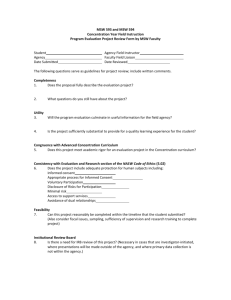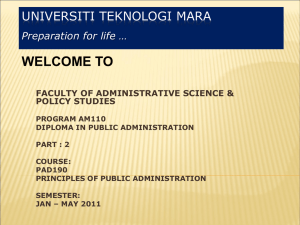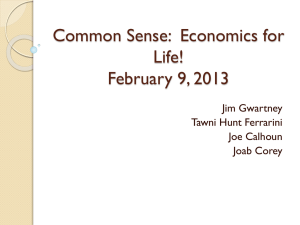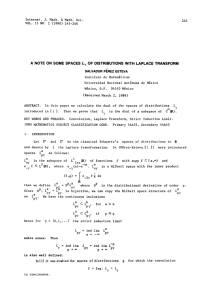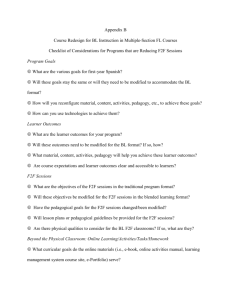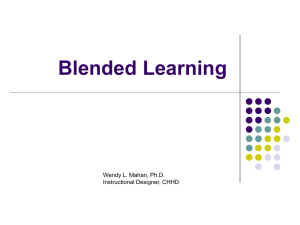Comparative analysis of an online and face-to
advertisement
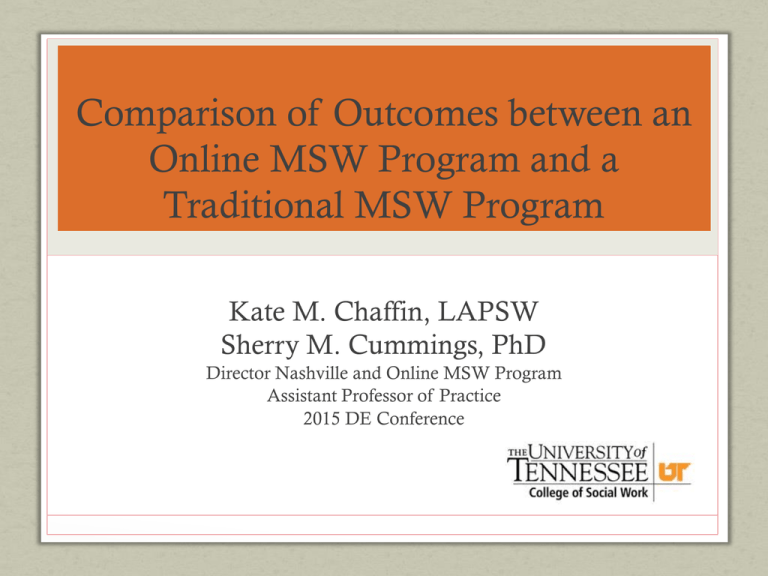
Comparison of Outcomes between an Online MSW Program and a Traditional MSW Program Kate M. Chaffin, LAPSW Sherry M. Cummings, PhD Director Nashville and Online MSW Program Assistant Professor of Practice 2015 DE Conference Literature Review • Currently 20 (2013) 35 2015 designated accredited DE programs • 9 are all online • 11 are hybrid using online, interactive TV, and satellite campuses • Online education can be defined as instruction and content which are delivered primarily over the internet (Watson & Kalmon, 2005). The term does not include printed-based correspondence education, broadcast television or radio, videocassettes, and standalone educational software programs that do not have a significant Internet-based instructional component (U.S. Department of Education Office of Planning, Evaluation, and Policy Development Policy and Program Studies Service, 2010). • Other terms used interchangeably with online are: Cyber-learning, e-learning, web-based and virtual learning. Social Work and Online Trends • Research surrounding course work comparing F2F/online: • • • • HBSE (Woehle and Quinn, 2009; Ligon, Markward, & Yegidis, 1999) Research (Faul, Frey, & Barber, 2004; Banks and Faul, 2007) Diversity (Hylton, 2006) Human Service Administration (York, 2008) • These studies have indicated no significant difference between the online and face-to-face groups Social Work and Online Trends Con’d • Studies also indicate no significant difference between face-to-face and online classes in teaching clinical skills online. (Siebert, Siebert, and Spaulding-Givens, 2006; Siebert and Spaulding-Givens, 2006; and Cummings, Foels, and Chaffin, in press) Comparing Programs • Little research has been conducted comparing entire MSW traditional programs with online MSW programs • Anderson and Fiedemann (2010) Certificate Program • Bettmann, Thompson, and Berzoff (2009) Social Work PhD program seminar • Wilke and Vinton (2006) Entire online advanced standing program Aspects of Successful Online Programming • Knowledge Gained • Skills obtained • Student satisfaction • • • • Ease of use of technology Students ability to interact with instructor Flexibility of classes Faculty engagement Dimensions of Online at UTKCSW • 2008 • Synchronous and Asynchronous • Online program identical to F2F program • FT, PT, AS programs • Faculty teach in both F2F and online classes Dimensions of Online at UTKCSW –con’d • Online program is composed of: Associate Dean, Director, Field Coordinator and a staff person • Clinical (EBIP) and Macro (MLCP) • Blackboard and Blackboard Collaborate • Tools for effective teaching include: discussion boards, wikis, blogs, video role-plays, VideoAnt, YouTube, Xtranormal Methodology Quasi-experimental research design Comparison of learning outcomes Knowledge Skills Satisfaction Students (n=345) graduated in May 2011 and 2012 Traditional (face-to-face) = 255 (73.9%) Online = 90 (26.1%) Measures • Demographics - age, race, gender, program and concentration • Comprehensive Exam scores • 10 essay questions - 2008 EPAS core competencies • 1-5 likert rating - how well demonstrated competencies and advanced practice knowledge and skills • Students graduating in May 2011 and 2012 n=334 • Chronbach’s α= .91 Measures • Overall GPA - measure of overall academic performance • All students graduating in May 2011-2012 - n=309 • Self-Efficacy Scale - pre and post test scores • Students’ confidence in ability to perform core skills related to practice • 41 items (1-11 likert rating) -based on 2008 EPAS • Students admitted in fall 2010 and graduated May 2012 - n = 89) • Chronbach’s α= .91 Measures • Field Competencies • 8 advanced field competencies linked to foundation core and advanced program competencies • Assessment, intervention, policy, leadership, ethics, evaluation, advocacy, professional development • End of semester evaluations by field instructors • Students completing field in May 2011 and 2012 n= 267 • 5 point likert ratings; Chronbach’s α= .93 Measures • Exit Surveys - students’ ratings of program effectiveness, foundation and concentration courses, and faculty • Faculty - accessibility and helpfulness • Major professor - accessibility and advising • “Overall, to what degree do you feel that this program provided you with the skills and knowledge needed to begin work as a masters prepared social worker?” • Students graduating in May 2012 - N=148 Findings Variable All Students F2F Students Online Students M (SD) or % M (SD) or % M (SD) or % 73.9% 26.1% 29.5 (8.8) 29.1 (9.1) 30.1 (8.0) Gender (Female) 86.4 84.3 92.2 Race (Caucasian) 74.8 74.5 75.6 Full-Time 43.2 48.6 32.7 Adv Standing 32.1 22.4 29.1 Ext Study 11.6 29.0 38.2 82.6 82.7 82.2 Instruct Method Age Program Concentration-EBIP Findings • Comp Exam Scores - ns for any of the 10 individual items or overall score • Overall range - 15.00-50.00, M=35.1 (5.6) • GPA • F2F - GPA=3.7; Online- GPA=3.6* • GPA by method and program F2F Online FT 3.76 (.20) 3.70 (.26) ESP 3.66 (.24) 3.69 (.21) AS 3.81 (.15) 3.65 (.20)* Findings • Self-Efficacy - Repeated Measures ANOVA • Main Effect of time - significant • Pre-test - M=33.9 (4.0) • Post-test - M=37.6 (2.8); F(1, 86) = 18.8, p = .001 • Time * Instructional Method - ns • F(1, 86) =.10, p > .05 • Similar gain in Self-Efficacy for Traditional and Online students Findings Field Competency All Students F2F Students Online Students M (SD) M (SD) M (SD) Assessment 4.3 (.76) 4.2 (.77) 4.5 (.70)** Intervention 4.1 (.80) 4.1 (.76) 4.3 (.81)* Policy 4.0 (.80) 3.9 (.80) 4.1 (.78)* Leadership 4.2 (.80) 4.1 (.80) 4.4 (.77)** Ethics 4.1 (.77) 4.3 (.77) 4.5 (.72) Evaluation 4.1 (.83) 4.0 (.82) 4.3 (.81)** Advocacy 4.2 (.80) 4.1 (.79) 4.4. (.78) * Prof Development 4.3 (.76) 4.3 (.76) 4.4 (.75) Findings Overall Field Competency Ratings - By Method & Program F2F Online All Students 32.9 (5.1) 34.8 (5.1) Full-time 32.7 (5.0) 34.6 (6.0) Advanced Standing 33.7 (5.0) 34.1 (5.3) Extended Study 36.2 (4.0)** 32.1 (5.8) Findings Student Exit Survey Ratings by Instructional Method M (SD) M (SD) M (SD) Faculty Access 3.6 (1.0) 3.5 (1.0) 3.9 (1.0)** Faculty Support 3.8 (1.0) 3.7 (1.1) 4.1 (.94)* Maj Prof Access 3.1 (1.5) 2.9 (1.5) 3.6 (1.3)** Maj Prof Advising 3.0 (1.5) 2.6 (1.5) 3.5 (1.4)*** Preparedness 3.8 (.95) 3.5 (.95) 4.3 (.76)** Discussion • Paucity of comparison outcomes studies for online programs • Discipline specific studies needed • Current study - online students performed as well as F2F • Exception GPA - further investigation is needed • Current study - satisfaction higher for online students • Related to online program staff; students’ desire for access to MSW program; other? Discussion • Further research - not only “what” by “why” • Include additional demographic data to compare f2f and online students - employment, hours worked, years of experience, etc. • Qualitative data to flesh out quantitative • Conduct more research surrounding best practices in online education • Evaluation of methods of delivery especially in regards to clinical classes since the majority of students in MSW programs are clinical tracks References • Anderson, K.H. & Friedmann, M.L. (2010). Strategies to teach family assessment and intervention through an online international curriculum. Journal of Family Nursing, 16, 213-233. • Banks, A., & Faul, A. (2007). Reduction of face-to-face contact hours in Foundation Research courses: Impact on student’s knowledge gained and course satisfaction. Social Work Education, 26 (8), 780-793. • Bettmann, J., Thompson, K., Padykula, N., & Berzoff, J. (2009). Innovations in doctoral education: Distance education methodology applied. Journal of Teaching in Social Work, 29 (3), 291-312. • Cummings, S., Foels, L., and Chaffin, K. (in press). Comparative analysis of distance education and classroom- based formats for a clinical social work practice course. Journal of Social Work Education. • Faul, A., Frey, A., & Barber, R. (2004). The effects of web-assisted instruction in a social work research methods course. Social Work Education, 23 (1), 105-188. • Hylton, M. (2006). Online versus classroom-based instruction: A comparative study of learning outcomes in a diversity course. The Journal of Baccalaureate Social Work, 11 (2), 102-114. References • Ligon, J., Marward, M., & Yegidis, B. (1999). Comparing student evaluations of distance learning and standard classroom courses in graduate Social Work education. Journal of Teaching in Social Work, 19 (1), 21-29. • Maidment, J. (2005). Teaching Social Work Online: Dilemmas and Debates. Social Work Education, 24 (2), 185-195. • Siebert, D.C., and Spaulding-Givens (2006). Teaching clinical social work skills online: A case example. Social Work Education, 25 (1), 78-91. • Siebert D.C., Siebert, C.F., & Spaulding-Givens, J. (2006). Teaching clinical social work skills primarily online. Journal of Social Work Education, 42, 325-336. • U.S. Department of Education Office of Planning, Evaluation, and Policy Development Policy and Program Studies Service (2010). Evaluation of Evidence-Based Practices in Online Learning: A Meta-Analysis and Review of Online Learning Studies. Washington, DC. Retrieved on November 7, 2012 from: http://www2.ed.gov/rschstat/eval/tech/evidence-based-practices/finalreport.pdf References • Watson, J. F., & Kalmon, S. (2005). Keeping pace with K–12 online learning: A review of state-levelpolicy and practice. Naperville, IL: Learning Point Associates. Retrieved on November 7, 2012 from http://www.learningpt.org/pdfs/tech/Keeping_Pace2.pdf • Wilke, D., and Vinton, L. (2006). Evaluation of the first-web based advanced standing MSW program. Journal of Social Work Education, 42 (3), 607-620. • Woehle, R., and Quinn, A. (2009). An experiment comparing HBSE Graduate Social Work Classes: Face-to-Face and at a distance. Journal of Teaching in Social Work, 29 (4), 418-430.
